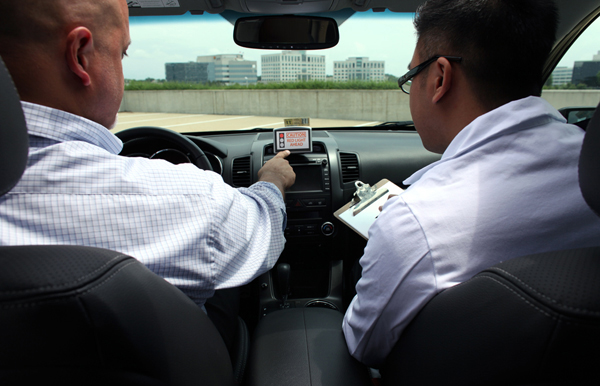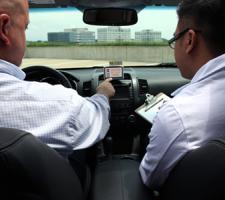
In the US, the ITS Joint Program Office is about to conduct a series of Driver Clinics intended to gauge public reaction to Connected Vehicle safety technologies and applications
Starting in August, theAccording to the ITS Joint Program Office (
Geographically, they have been deliberately chosen to allow the US DOT to gain insight into different drivers' perceptions of and reactions to the V2V concept and applications, recognising that driving styles and preferences vary considerably across a country as large as the US. And, as well as allowing members of the public to gain insight, the test locations will allow the
Locations were chosen not only to test a diverse driver pool but also to enable researchers to test the effectiveness of DSRC technology in different environments and terrains. For example, Minnesota provides the ITS JPO with an opportunity to test DSRC in a very open rural environment, while San Francisco will allow the researchers to explore how the technology works in an urban setting with multiple hills, sinuous roads and massive steel and concrete buildings. The Connected Vehicle test cars will also test DSRC over long distances when they are driven from Michigan to Chicago and through the mountainous terrain of Appalachia while travelling from Washington, DC to Blacksburg, Virginia.
V2I - still in the mix
The focus on V2V reflects the pending 2013 decision by the National Highway Traffic Safety Administration (NHTSA) over whether to mandate the fitment of such systems to new-build cars and light vehicles and does not, according to the ITS JPO, represent a dilution of the Vehicle-to-Infrastructure (V2I) effort.The Driver Clinics are in part intended to support the 2013 decision by providing user acceptance data. For example, if the onboard systems supporting V2V are annoying to the driver, this could lead to them being ignored and so becoming ineffective.
The emphasis in these Driver Clinics is on light vehicles. There were two reasons for this: cooperative research conducted by the leading automotive manufacturers in the US within the Crash Avoidance Metrics Partnership (CAMP) has tended to concentrate on cars and is so more advanced; and the work conducted at this stage on light vehicles will also feed into the planning stages for heavier vehicles (for which a NHTSA decision on V2V systems' mandatory fitment will follow in 2014).
The decision to accelerate the V2V portion of the V2V/V2I cooperative infrastructures envisaged under the original Vehicle- Infrastructure Integration (VII) programme and its subsequent iterations also underscores a certain pragmatism, one which recognises the tremendous pay-offs which could be achieved in the near term using the tools at hand rather than waiting for the extended period to pass which will see all infrastructure-side systems deployed.
The ITS JPO acknowledges the somewhat reduced visibility of its V2I work but says that its safety, information and environmental systems and applications remain no less relevant or current. Enabling technical work goes on, for example, on signal phases and timing which will drive such things as speed advisories and so serve, for instance, safety, mobility and environmental applications. Development continues as well of systems to improve the general provision of information from the roadside, including the at-intersection Geometric Information Description mapping through which the various Cooperative Intersection Collision Avoidance Systems (CICAS) applications can 'know' what a given intersection looks like.
In many cases the (relative) potential ease with which V2V applications can be fielded is not just as a result of technological factors; V2I involves a much greater number of stakeholders.
Nevertheless, the ITS JPO is working to have compiled a list of what it considers the priority V2I applications by the end of this year which will be based in part on a V2I safety concept of operations currently under development. Once the shortlist of V2I applications is defined, they will be prototyped and field-tested.
Controlled testing
Despite being billed as taking place in normal operating conditions, the Driver Clinics will take place in off-road, controlled environments, such as racetracks or large parking lots, where those under test can be isolated from the general traffic. This will allow engineers to force execution of safety warnings, surprising and distracting the drivers under test - something which clearly cannot be done in a more open environment. Test drivers will be evenly split according to gender and will come from three age groups: under 30; between 40 and 50; and over 60.V2V applications to be tested will include: Forward Collision Warning; Emergency Electronic Brake Light; Intersection Movement Assist (which will provide drivers with some indication of whether or not it is safe to pull out); Do Not Pass; and Blind Spot Warning. These have been defined within CAMP and are seen as the most promising in terms of highly positive safety payoffs and near-term deployability.
DVIs and driver distraction
The V2V technologies as presented to the test subjects will stem from the pre-competitive work done by CAMP. This collaborative environment will result in generic elements and applications being showcased. OEM-customised Driver-Vehicle Interfaces (DVIs) which include different combinations of audio-visual and haptic alerts (such as vibrating seats) will follow at the production stage.The potential for driver distraction is seen as a big safety issue.
Any DVI which is fielded at the production stage by an OEM will, for instance, have to meet strict safety performance criteria howsoever it combines the various means of alerting a driver.
Significant effort has already gone into the human factors elements of the Connected Vehicle/cooperative infrastructure programme in the US. DVI development criteria include those for after-market devices, as it is recognised that such devices will play a significant part at least in the early stages of deployment of some applications. The ITS JPO says that it is pushing for technology but in a very carefully constructed way such that it does not lead to distraction issues. Eventually, it is hoped that there will be NHTSA guidelines which will apply especially for safety but also for comfort applications.
Follow-on Model Deployment
The Driver Clinics will take place over a period of about six months. The next step will be a Model Deployment. The procurement process for this is currently underway, with an expected award later this year. This will take V2V in the US into a technical evaluation period of a small deployment of around 3,000 vehicles instrumented with a variety of different Connected Vehicle devices.CAMP has explored the use of DVIs integrated with vehicle databuses and these represent the high-end application of such technologies. Coming down the scale, some vehicles will feature aftermarket devices which are not integrated into the vehicle.
These offer somewhat less functionality as they are not able to access vehicle-based sensor data. So, for example, they might offer proximity warnings but be unable to give haptic outputs.
Next in line are what have so far been called 'Here I Am' devices, although the ITS JPO says that it is trying to move away from this term and find something more in line with its capabilities and purpose - which is as a safety beacon broadcasting the location of the host vehicle.
Taken in its entirety, the Model Deployment is intended to presage what will happen in the real world. With over 250 million vehicles on the roads in the US it is unrealistic to look to a point where all are equipped as new with a fully integrated DVI, and an appreciation is necessary of the effects of the 'cascade' of technologies expected to be in use once V2V goes live. Again, near-term gains are a stated aim and the ITS JPO has indicated that useful results can be achieved with as little as 8 per cent of the national fleet being capable of communicating with one another.
Safety Pilot Driver Clinics
The Safety Pilot Driver Clinics will take place in the following locations
• 8-11 August at the Michigan International Speedway in Brooklyn, MI
• 19-22 September at Brainerd International Speedway in Brainerd, MN
• 22-25 October at the Richard Petty Driving Experience in Orlando, FL (There will also be a similar technology event during the 18th Annual World Congress on Intelligent Transportation Systems)
• 6-9 November at Smart Road (Virginia Tech Transportation Institute) in Blacksburg, VA, along with public demonstration in Washington, DC on 10 November, 2011.
• 5-7 December at Texas Motor Speedway in Fort Worth, TX
• 16-19 January at the Alameda Naval Air Station in Alameda, CA














